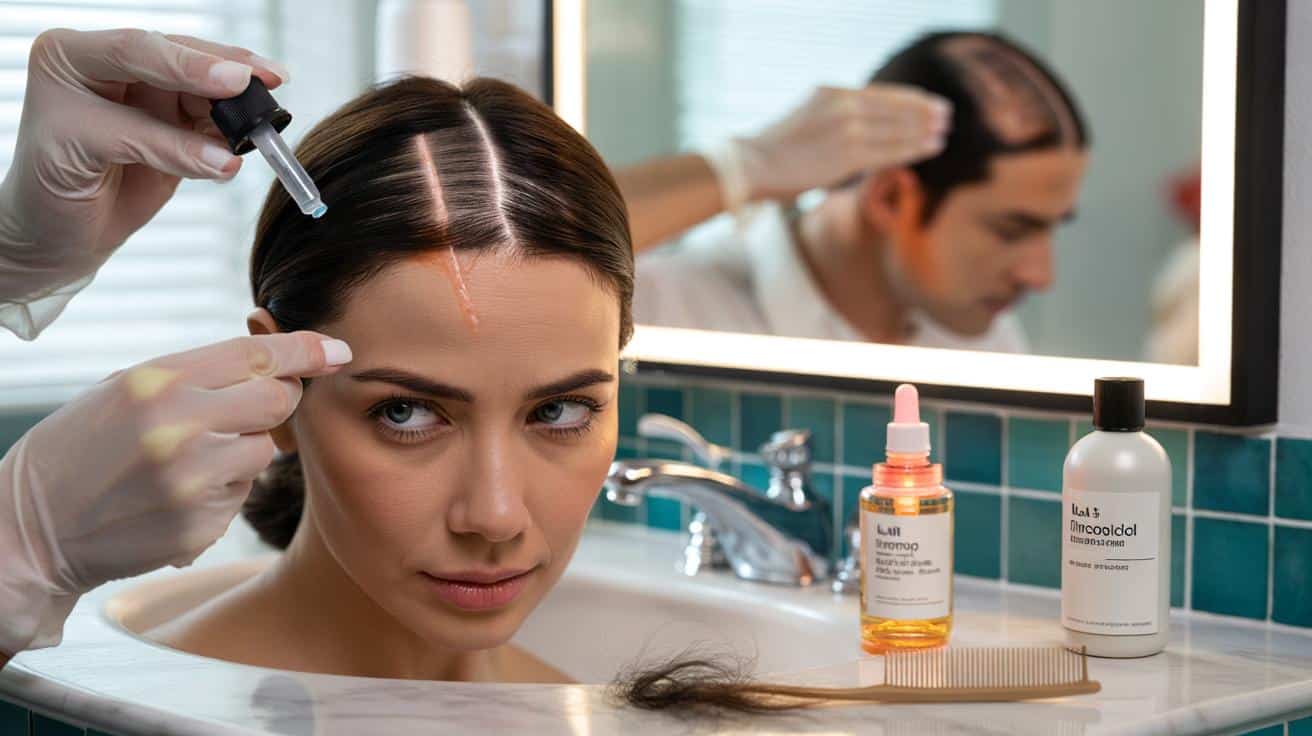The part looks wider. Showers end with a small, guilty glance at the drain. Hair thinning sneaks in quietly, then takes up space in your head. Is it stress, hormones, a harsh bleach, or your genetics waking up? The mirror won’t say. The scalp whispers clues.
The first thing I noticed was the way the bathroom light fell across my crown. Not dramatic, just different. A hairdresser paused, tilted her head, and suggested a gentle parting change “for volume.”
I started clocking the shed hairs on my keyboard, the little tumbleweeds near the plughole. A friend blamed her marathon training. Another said it was postpartum. The barber muttered “cowlick” and kept moving. *What if the fix isn’t on the shelf?*
What’s really driving thinning: not just one thing
Hair grows in cycles. Some follicles work, some rest, some shed, ideally in balance. When that rhythm gets nudged—by hormones, health shifts, or traction—the shed can outpace the regrowth you can actually see.
For many, it’s pattern thinning: a widened part in women, a receding edge in men. For others, it’s a sudden shed after illness, high stress, or giving birth. The scalp tells the story long before the mirror shouts it.
By 50, about 80% of men and nearly half of women notice some thinning. A 29-year-old new mum sees handfuls for three months, then settles. A 41-year-old with PCOS watches her ponytail slim down. A 32-year-old realises his hairline used to start somewhere else. Different origins, same unease.
Genetics set the stage. Hormones—testosterone converting to DHT, oestrogen falling post-baby or around perimenopause—direct the play. Iron and vitamin D shape the hair cycle’s energy. Inflammation adds static. Styling habits tug at the edges. Treat the cause you have, not the cause you fear.
Treatments that actually work (derms and trichologists agree)
Start with **Minoxidil 5%** once daily to the thin zones. Foam or liquid, dry scalp, two pumps or 1 ml, tap into the part lines, not your fringe. Give it 3–6 months before judging. Early shedding can happen; it’s the cycle syncing, not failure.
Keep the scalp calm. Use a gentle shampoo, and bring in ketoconazole 1–2% twice a week if flaking or oiliness join the party. We’ve all had that moment when a tight pony seems the only fix—ease the tension and rotate styles. Let’s be honest: nobody really does that every day.
For men with pattern loss, **Finasteride (for men only)** lowers DHT and slows miniaturisation. Women not planning pregnancy might discuss spironolactone for hormone-driven thinning. **Low-level laser therapy (LLLT)** can stimulate follicles a few times a week, and microneedling at 1–1.5 mm, once weekly, boosts topical delivery. Bloods matter: ferritin, vitamin D, thyroid.
“I tell patients: hair is a lagging indicator. What you see today began months ago. Consistency beats intensity,” says Dr Anna Clarke, consultant dermatologist.
- Postpartum shed? Gentle styling, minoxidil if breastfeeding-safe guidance fits, and time—most recover by month 9–12.
- Pattern thinning? Combine minoxidil with oral therapy (men: finasteride; women: discuss spironolactone) and consider clinic options like PRP.
- Inflammation or itch? Rule out seborrhoeic dermatitis or psoriasis; medicated shampoos can calm the ground.
- Traction alopecia? Loosen braids, avoid edges glue, shift partings. Early change is key to reversibility.
- Nutrition? Aim ferritin >50–70 µg/L for robust growth; treat anaemia, check B12, zinc, and thyroid with your GP.
Rethinking your hair future
There’s the panic phase, then there’s the plan. You don’t need twenty products—just a clear map for your scalp: identify the driver, pick one or two proven tools, stick with them long enough to judge.
Stock photos show glossy sheets of hair and easy answers. Real life is slower. Hair cycles on a quiet clock, and your reflection lags behind your routine by months.
Change the controllables: tension, harsh colour, crash dieting, poor sleep. If you’re unsure, a trichologist or dermatologist can read the scalp like a weather report and point you in the right direction. The best day to start was last season. The second-best is tonight.
Apply minoxidil with intent: map your part lines, photograph monthly in the same light, and set a reminder at night. Pair it with scalp kindness—medicated wash once or twice weekly, light conditioner from mid-lengths down, and wide-tooth detangling. Tiny disciplines, stacked, are how hair changes direction.
Common traps: quitting at week eight, flooding the scalp (it doesn’t speed results), and chasing every supplement on social media. If your shedding spiked after illness or intense stress, note the lag: the shed often shows up 8–12 weeks later. Compassion helps compliance.
When genetic thinning is in play, add a prescription track or a device track, not both at once. Track one change for three months, then layer.
“Treat the scalp like skin—cleanse, treat, protect. And be patient. Healthy hair is a slow win,” says consultant trichologist Mark Reynolds.
- Microneedling: 1.0–1.5 mm roller or pen, once weekly, light pressure, then topicals 24 hours later.
- LLLT cap or comb: 3–4 sessions weekly, 10–20 minutes, look for medical-grade diodes.
- PRP in clinic: 3 sessions, 4–6 weeks apart, then maintenance if you respond.
- Medication review: men—finasteride; women—discuss spironolactone or topical antiandrogens if suitable.
- Lifestyle audit: ferritin and vitamin D targets, protein at each meal, and a sleep schedule your hair can trust.
Thinning hair asks you to look closer at everything else—hormones shifting, a thyroid dragging, a training plan that pushed too far. It can feel personal. It isn’t. It’s biology, and biology responds to consistent nudges.
You don’t have to fix it all this week. Choose one lever to pull and start the clock. Share photos with a trusted friend or your stylist. Keep notes. The mirror will catch up to the routine you keep.
Some causes resolve on their own; others require that steady, boring care. That’s not a failure. That’s how follicles vote for longevity. And if someone needs to hear it today: fuller-looking hair often arrives before regrowth, and that counts too.
| Point clé | Détail | Intérêt pour le lecteur |
|---|---|---|
| Identify the driver | Pattern loss, telogen effluvium, traction, or inflammation | Targets effort where it works, not where it wastes time |
| Use proven tools | Minoxidil, oral therapy when indicated, LLLT, microneedling, PRP | Higher odds of visible gains in 3–6 months |
| Scalp-first habits | Ketoconazole wash, tension-free styling, nutrition labs | Builds a healthier “soil” for consistent growth |
FAQ :
- Will my hair grow back?It depends on the cause. Postpartum and stress-related shedding often reverse. Pattern thinning is chronic but manageable; the goal is stabilise, thicken, and maintain.
- How long until I see results?Topicals and devices: 3–6 months for density changes, 6–12 months for peak gains. Oral therapies: many notice less shedding by month two or three.
- Which blood tests should I ask about?Ferritin, full blood count, thyroid panel (TSH, free T4, free T3), vitamin D, B12, and zinc if diet is limited. Your GP can help interpret in context.
- Is rosemary oil a real alternative to minoxidil?It can improve scalp comfort and shine, and small studies are promising, but evidence isn’t as robust as minoxidil. You can layer it for scalp health, not as a replacement for most people.
- Can tight braids or slick buns cause permanent loss?Yes, long-term traction can scar follicles. Rotate styles, loosen tension, and treat early. The earlier you pivot, the more reversible it is.








